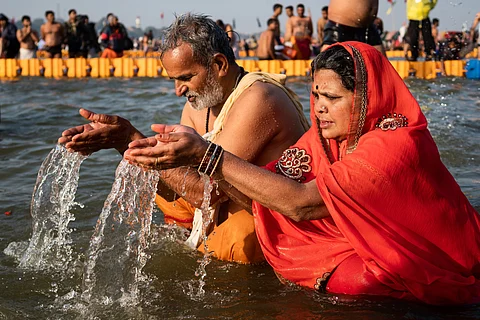
- Destinations
- Experiences
- Stay
- What's new
- Celebrating People
- Responsible Tourism
- CampaignsCampaigns
- SubscribeSubscribe
- Buy Now

The Maha Kumbh Mela takes place once every 12 years in Prayagraj, formerly known as Allahabad, in Uttar Pradesh. The last Maha Kumbh Mela, which was held in 2013, attracted a record 10 crore people and generated revenue of INR 12,000 crore. It is the world’s largest public gathering and collective act of faith, with congregants including ascetics, sadhus, Kalpvasis and pilgrims from all walks of life.
This year, the Maha Kumbh Mela takes place from January 13 to February 26. The state government expects a staggering 40 crore devotees to take the holy dip in the Triveni Sangam, the confluence of the Ganges, Yamuna and the mythical Saraswati rivers. Here are six of the most auspicious and holy days you should look out for during the Maha Kumbh Mela 2025.
The Paush Purnima occurs on the 15th day of the Shukla Paksha (waxing phase) in the Hindu calendar month of Paush and heralds the arrival of the full moon. It serves as the unofficial inauguration of the Maha Kumbh Mela. Additionally, the Paush Purnima marks the initiation of Kalpvasa, a period of intense spiritual practice and devotion observed by pilgrims. This day is considered auspicious to get blessings from the Moon god, with devotees offering prayers to Lord Vishnu and Lord Surya.
Makar Sankranti signifies the sun's transition to its next astronomical position in accordance with the Hindu calendar and is the day when the first Shahi Snan (royal bath) takes place. This auspicious day marks the start of charitable donations at the Maha Kumbh Mela. Pilgrims traditionally make contributions based on their own volition and generosity.
Mauni Amavasya is a day steeped in significance, as it is believed that the celestial alignments are the most propitious for the sacred act of bathing in the Triveni Sangam. It commemorates the event when Rishabh Dev, revered as one of the first sages, broke his protracted vow of silence and immersed himself in the purifying waters of the Sangam. As a result, this day draws the largest congregation of pilgrims to the Maha Kumbh Mela for spiritual devotion and purification practices.
The occasion of Basant Panchami symbolises the transition of the seasons and celebrates the arrival of the Goddess of Knowledge, Saraswati, in Hindu mythology. To honour the significance of the day, Kalpavasis adorn themselves in vibrant yellow attire.
The Maghi Purnima is renowned for its connection with the veneration of Guru Brahaspati and the belief that the Hindu deity Gandharva descended from the heavens to the sacred Sangam. On this day, the holy ghats witness a significant influx of pilgrims, driven by the conviction that their presence at this auspicious moment will guide them towards heavenly realms while still in their earthly forms.
The Maha Kumbh Mela’s final day is on the occasion of Maha Shivaratri, which holds deep symbolism as it marks the final holy bath of the Kalpvasis, and is intrinsically connected to Lord Shiva. On this day, devotees fast and meditate on the ethics and virtues of honesty, charity and forgiveness. Many people visit Shiva temples or embark on pilgrimages to Jyotirlingams during this day.
